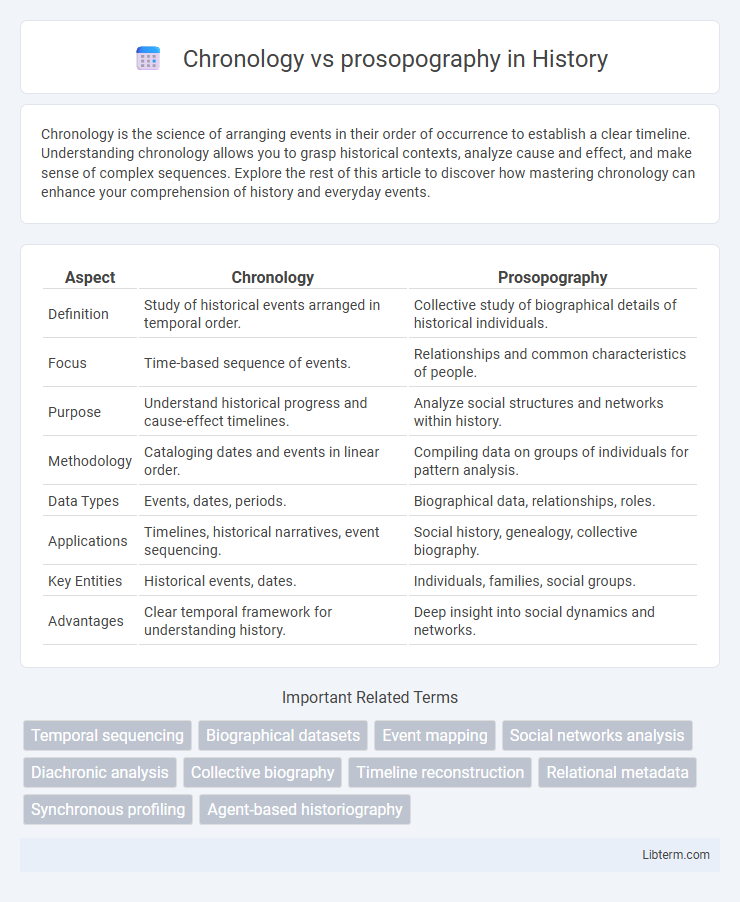Chronology is the science of arranging events in their order of occurrence to establish a clear timeline. Understanding chronology allows you to grasp historical contexts, analyze cause and effect, and make sense of complex sequences. Explore the rest of this article to discover how mastering chronology can enhance your comprehension of history and everyday events.
Table of Comparison
| Aspect | Chronology | Prosopography |
|---|---|---|
| Definition | Study of historical events arranged in temporal order. | Collective study of biographical details of historical individuals. |
| Focus | Time-based sequence of events. | Relationships and common characteristics of people. |
| Purpose | Understand historical progress and cause-effect timelines. | Analyze social structures and networks within history. |
| Methodology | Cataloging dates and events in linear order. | Compiling data on groups of individuals for pattern analysis. |
| Data Types | Events, dates, periods. | Biographical data, relationships, roles. |
| Applications | Timelines, historical narratives, event sequencing. | Social history, genealogy, collective biography. |
| Key Entities | Historical events, dates. | Individuals, families, social groups. |
| Advantages | Clear temporal framework for understanding history. | Deep insight into social dynamics and networks. |
Introduction to Chronology and Prosopography
Chronology organizes historical events by date, providing a temporal framework essential for understanding the sequence and causality in history. Prosopography studies the collective biography of groups, revealing social structures and relationships through detailed examination of individuals' lives and careers. Both methods complement each other by combining temporal order with social context for comprehensive historical analysis.
Defining Chronology in Historical Research
Chronology in historical research establishes an accurate timeline of events, enabling scholars to sequence occurrences and analyze causality within specific periods. It involves precise dating techniques, including calendar systems and radiocarbon dating, to anchor historical narratives in time. This temporal framework contrasts with prosopography, which emphasizes collective biography to understand social structures rather than chronological order.
Defining Prosopography and Its Scope
Prosopography is a research method that systematically studies the common characteristics of historical groups by analyzing collective biographical data. Its scope extends beyond individual life stories to explore patterns, social structures, and networks within specific populations across time periods. Unlike chronology, which orders events sequentially, prosopography emphasizes relationships and shared attributes among people to understand societal dynamics.
Key Differences Between Chronology and Prosopography
Chronology organizes historical events in a sequential timeline, emphasizing dates and temporal relationships, while prosopography analyzes collective biographies to identify patterns among groups of individuals within a specific context. Chronology provides a framework for understanding when events occurred, whereas prosopography offers insights into social connections, roles, and characteristics of historical figures. The key difference lies in chronology's focus on temporal order versus prosopography's concentration on biographical data and social structures.
Historical Significance of Chronological Analysis
Chronological analysis provides a structured timeline that enables historians to trace the sequence and causality of events, thereby uncovering patterns and contextual correlations essential for understanding historical developments. This method allows for precise dating and synchronization of events across different regions, enhancing the accuracy of historical narratives. Compared to prosopography, which centers on collective biography and social connections, chronology offers a foundational framework critical for situating those relationships within an accurate temporal context.
The Role of Prosopography in Social History
Prosopography plays a crucial role in social history by systematically analyzing collective biographies to reveal patterns of social structures, relationships, and power dynamics over time. Unlike chronology, which focuses on sequential events, prosopography examines groups of individuals to uncover underlying social connections and status changes within historical contexts. This method enhances understanding of societal hierarchies, kinship networks, and institutional roles essential for reconstructing historical communities and their interactions.
Methodologies Used in Chronology Studies
Chronology studies primarily utilize methods such as stratigraphy, dendrochronology, radiocarbon dating, and the analysis of historical records to establish accurate timelines of events and artifacts. These techniques enable researchers to sequence occurrences and cross-reference data points for temporal accuracy. Contrastingly, prosopography emphasizes collective biography and social network analysis, focusing on relationships between individuals rather than the precise dating of events.
Data Collection Techniques in Prosopographical Research
Prosopographical research relies on systematic data collection techniques such as archival research, database compilation, and analysis of historical records to gather biographical information about groups of individuals. This method contrasts with chronology, which primarily focuses on sequencing events over time rather than collecting detailed personal data. Utilizing structured data collection tools enhances the identification of patterns and relationships within social networks in prosopographical studies.
Applications and Case Studies: Chronology vs Prosopography
Chronology and prosopography serve distinct yet complementary roles in historical research, with chronology organizing events sequentially to establish timelines and prosopography analyzing collective biographies to uncover social structures and relationships within historical populations. In applications, chronology is critical in constructing event sequences for political or military history, while prosopography excels in studying elite networks, social mobility, and institutional dynamics by aggregating biographical data. Case studies demonstrate chronology's use in wars or reigns, whereas prosopography reveals patterns in groups such as clergy, nobility, or parliamentary members, enriching understanding of historical contexts beyond mere dates.
Combining Chronology and Prosopography for Holistic Insights
Combining chronology and prosopography allows historians to construct detailed timelines that integrate individual life histories with broader social patterns, enhancing the understanding of historical events within specific temporal contexts. This interdisciplinary approach utilizes chronological data to sequence events while employing prosopographic analysis to identify relationships, social networks, and collective characteristics of historical figures. Integrating these methods yields comprehensive insights into historical dynamics, enabling nuanced interpretations of how individual and group actions influenced temporal progressions.
Chronology Infographic

 libterm.com
libterm.com